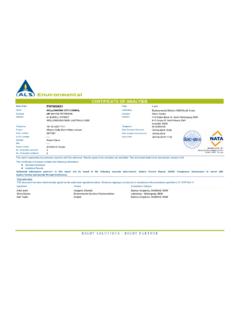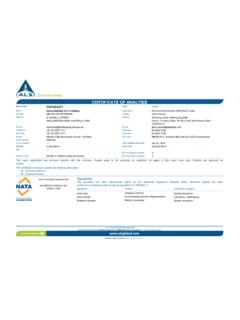Transcription of EAST END OF RUNDLE (EEOR) - Banff Rock
1 EAST END OF RUNDLE (EEOR). EEOR is a long cliff, nearly 500 m high, situated on the opposite side of Whiteman Gap from Ha Ling Peak. Three huge, right-slanting, ramp-like corners are the most easily recognized land- marks of the face. From left to right, these are climbed by Guides' Route, Balzac and MacKay Route. The quality of the rock is very variable but in some areas it is unusually good. Naturally occurring rockfall is more frequent, however, than on most other local cliffs because of a large snowfield that forms above the cliff and continues to contribute melt water until well into the summer. A cornice often exists early in the year and there has been at least one close call involv- ing its collapse. Considering its proximity to Canmore and favourable aspect, the cliff has seen little development. Fortunately, the summer of 1998 saw renewed interest in the cliff and the addition of several big lines.
2 A number of projects are currently underway and in the next few years EEOR's interesting features and, in many places, excellent rock will likely produce many worthwhile new climbs of all styles. Approach Park on the west side of Whiteman Pond at the wide pullout a few hundred metres south of the dam and follow a trail that begins slightly to the north and goes up a sparsely treed, shallow depression directly toward Kanga Crag. The main trail leads up past the right end of Kanga and continues up steep scree slopes following cliff bands to the left end of EEOR. For Raptor and the True Grit area it is best to stay on the trail beneath the cliffs all the way to the base of the climbs, but for Reprobate and climbs farther north, a small trail diagonals right from below Spud Crag to join the trail that runs beneath the main face across to the north ridge. Guides' Route and climbs farther north can also be reached via a faint trail that climbs the wooded ridge opposite the dam and then ascends the scree slopes directly to the base of the cliff.
3 Descent To reach the road, the easiest route follows the top of the cliff south over scree and alpine meadows down to a nearly level treed ridge. A good hiking trail runs along the ridge (leading up to the first summit above EEOR) and this may be followed down to the Spray Lakes road, reaching it near the tunnel in the diversion canal. An alternative descent that may be used to reach the base of the cliff is to cut down left where the ridge first levels off and then rises slightly. A flagged trail goes down treed slopes toward the top of Kanga Crag and then angles over left through easy cliff bands to join the approach trail at the lower end of Spud Wall, about 200 m below the main face. Extra care is necessary in the lower section to avoid dislodging loose rock that may fall onto the approach trail directly below. Fumbles 450 m, M. Dahlie & P. Smith, July 1980.
4 This route follows the large, loose gully at the beginning of the main cliff. The gully is now used Mount RUNDLE - 367. as an alternative descent route from the True Grit area and few people, if any, would want to do it as a climb. However, the upper pitches could be used to reach the top of the cliff as a continuation of the True Grit climbs. The climb ascends the lower gully and then continues up a second gully to gain a large basin at about half height. Above, the route can be varied, but aims generally for a scree basin on the left below the exit chimneys. The top is then reached by following the chimneys that slant up to the left, and a large overhang is avoided by a short detour on to the face. Lucky Dog 80 m, P. Giguere & J. Racette, September 1997. This two-pitch route climbs to the top of a pinnacle on the right wall of the large amphitheatre in the upper part of the Fumbles gully .
5 The wall is actually the left side of the headwall above the True Grit area and the climb could be used to extend any of those routes. At present, it goes only to the top of the pinnacle, but a project called The Leash continues partway up the wall above and should be completed to the top in the near future. The route was originally done using gear but bolts have now been added to the second pitch that climbs a wide crack. A standard rack is still required and a #4 cam is useful for the second pitch. The rock is reported to be excellent. Note When climbing this route or the upper part of the Fumbles gully extra care is necessary not to dislodge loose rock down the gully and onto the lower part of Raptor. The climb may be reached either from the ledge system at the top of the True Grit area or more easily from partway up pitch 4 of Raptor. In the latter case, easy ground leads rightward to a slanting ledge system with small trees (rappel station see Raptor topo) and then over to the Fumbles gully .
6 Scramble up the gully to the base of a dihedral/ramp system on the right- hand side of the pinnacle. 1) 45 m, Follow the corner to a two-bolt belay at a ledge. 2) 35 m, Continue up the crack, which is difficult at first and becomes quite wide higher up. At the top of the pinnacle there is a two-bolt belay and rappel station. Opposite: Climbers at the top of EEOR looking across at Ha Ling Peak and the Spray Valley. Photo Grant Statham. Mount RUNDLE - 369. True Grit Area This is an area of steep, slabby rock at the extreme left end of the cliff. It is bounded on the left by the gully of Fumbles and extends to about two-thirds height where it ends at the base of a large, overhanging headwall. The quality of the rock is unusually good and the face offers some of the best steep friction-climbing in the area. The first route climbed was Geriatric, a traditional- style climb that is still worth doing.
7 However, the two more recent sport routes, True Grit and Parallel Dreams, make better use of the rock and are justifiably popular. Recently, a fourth route, Econoline, has been added that has mixed gear and bolts. Descent The four climbs end at a ledge system below the upper headwall and there are currently two ways to descend from this point. The climb True Grit is fixed for 25 m rappels with a short section of scrambling to the top of pitch 3 (see topo). The route is very popular, however, and recently extra stations have been added to minimize congestion. Two 50 m ropes are required when using the new stations, which are situated as shown on the topo (left of the fourth belay, up and right of the second belay, and on the wall to the right of the first pitch). A second means of descent is down the gully of Fumbles. This involves scrambling down to a ledge system that leads out right (south) past several small trees to a bolted station (see Raptor topo).
8 A short rappel leads to the top of pitch 3 of Raptor and three more 25 m rappels reach the ground. When using this descent, extreme care is necessary to avoid dislodging loose rock onto parties climbing Raptor. The headwall above the True Grit area is presently unclimbed, but a partially completed route begins up a steep corner just left of the edge, overlooking the Fumbles gully . Two pitches have been climbed and the route will probably be completed in the near future. Alternatively, the route Lucky Dog gives two more pitches farther left in the upper bowl of the Fumbles gully . Parallel Dreams** 180 m, J. Jones & G. Zederayko, 1990. Parallel Dreams is a sport route, similar to True Grit, but has more widely spaced bolt protection. It is harder than True Grit both technically and mentally. Overall the rock is excellent but on pitch 2 and parts of pitch 4 it is cheese-grater rough and the consequences of a fall are unsettling.
9 However, the bolt spacing is just sufficient to prevent anything worse than major skin loss. Start as for True Grit by following the ledges out right to the small gully and then scrambling up and left to a bolt belay below a prominent, deep chimney. 1) 30 m, Move up into the chimney and then out right on a ramp to an overhang. Make difficult moves up and right around this and continue up and slightly left to a semi- hanging stance. 2) 40 m, Step left and climb straight up on viciously prickly rock to a small overlap. Turn this on the right and continue more or less straight up. Near the top of the pitch follow slabby rock to the right to avoid a loose groove on the left. Belay on the front of a large 370 - Mount RUNDLE F. B C D&E. Raptor Wall A Raptor B D. B Parallel Dreams C. C True Grit A. D Geriatric E Econoline E. F Lucky Dog True Grit Part 1. 372 - Mount RUNDLE True Grit Part 2.
10 A Parallel Dreams** 10d/11b B True Grit** 10a/b C Geriatric* gear D Econoline* gear Mount RUNDLE - 373. pinnacle on the terrace that splits the face. This pitch is very sustained and the hardest on the climb overall. 3) 25 m, Move the belay to the True Grit station at the right-hand end of the terrace and begin as for that route. After gaining the bolt at the small ledge immediately above and right of the belay, follow a line of bolts diagonally left across the face to the large, right-facing corner of Geriatric. Climb the wall on the left past two bolts to a semi-hanging belay. 4) 35 m, Follow the bolts up and slightly right on prickly rock at first and then on more friendly ground to a bolt belay at a sloping ledge. 5) 50 m, Move up and right to the overhang above and make a difficult step up over this on side pulls (the second bolt is hard to see from below).







